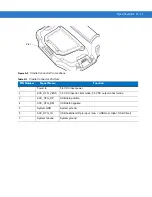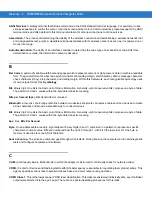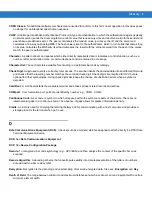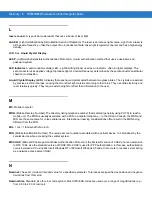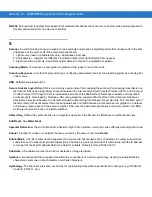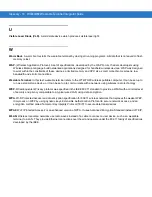
Glossary - 3
CDRH Class 2.
No additional software mechanisms are needed to conform to this limit. Laser operation in this class poses
no danger for unintentional direct human exposure.
CHAP.
(Challenge Handshake Authentication Protocol) A type of authentication in which the authentication agent (typically
a network server) sends the client program a random value that is used only once and an ID value. Both the sender and
peer share a predefined secret. The peer concatenates the random value (or nonce), the ID and the secret and
calculates a one-way hash using MD5. The hash value is sent to the authenticator, which in turn builds that same string
on its side, calculates the MD5 sum itself and compares the result with the value received from the peer. If the values
match, the peer is authenticated.
Character.
A pattern of bars and spaces which either directly represents data or indicates a control function, such as a
number, letter, punctuation mark, or communications control contained in a message.
Character Set.
Those characters available for encoding in a particular bar code symbology.
Check Digit.
A digit used to verify a correct symbol decode. The scanner inserts the decoded data into an arithmetic formula
and checks that the resulting number matches the encoded check digit. Check digits are required for UPC but are
optional for other symbologies. Using check digits decreases the chance of substitution errors when a symbol is
decoded.
Cold Boot.
A cold boot restarts the wearable terminal and erases all user stored records and entries.
COM port.
Communication port; ports are identified by number, e.g., COM1, COM2.
Continuous Code.
A bar code or symbol in which all spaces within the symbol are parts of characters. There are no
intercharacter gaps in a continuous code. The absence of gaps allows for greater information density.
Cradle.
A cradle is used for charging the terminal battery and for communicating with a host computer, and provides a
storage place for the terminal when not in use.
D
Data Communications Equipment (DCE).
A device (such as a modem) which is designed to attach directly to a DTE (Data
Terminal Equipment) device.
DCE.
See
Data Communications Equipment
.
DCP.
See
Device Configuration Package
.
Decode.
To recognize a bar code symbology (e.g., UPC/EAN) and then analyze the content of the specific bar code
scanned.
Decode Algorithm.
A decoding scheme that converts pulse widths into data representation of the letters or numbers
encoded within a bar code symbol.
Decryption.
Decryption is the decoding and unscrambling of received encrypted data. Also see,
Encryption
and
Key
.
Depth of Field.
The range between minimum and maximum distances at which a scanner can read a symbol with a certain
minimum element width.
Summary of Contents for WT4090
Page 1: ...WT4070 90 Wearable Terminal Integrator Guide ...
Page 2: ......
Page 3: ...WT4070 90 Wearable Terminal Integrator Guide 72E 87638 07 Rev A April 2015 ...
Page 6: ...iv WT4070 90 Wearable Terminal Integrator Guide ...
Page 14: ...xii WT4070 90 Wearable Terminal Integrator Guide ...
Page 20: ...xviii WT4070 90 Wearable Terminal Integrator Guide ...
Page 55: ...Accessories 2 25 Figure 2 25 Disconnecting Connector with Shroud Connector Eject Hole ...
Page 56: ...2 26 WT4070 90 Wearable Terminal Integrator Guide ...
Page 62: ...3 6 WT4070 90 Wearable Terminal Integrator Guide ...
Page 66: ...4 4 WT4070 90 Wearable Terminal Integrator Guide ...
Page 138: ...6 32 WT4070 90 Wearable Terminal Integrator Guide ...
Page 162: ...8 2 WT4070 90 Wearable Terminal Integrator Guide ...
Page 166: ...9 4 WT4070 90 Wearable Terminal Integrator Guide ...
Page 190: ...A 12 WT4070 90 Wearable Terminal Integrator Guide ...
Page 205: ......











